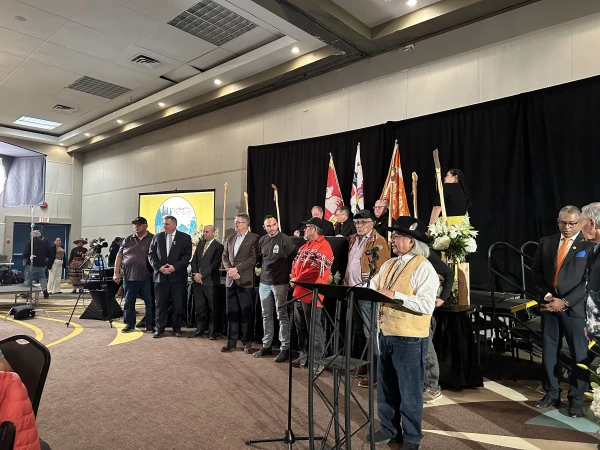CNA Staff, Apr 2, 2024 / 15:45 pm
The Archdiocese of Vancouver on Easter Sunday signed a “sacred covenant” pact with the Indigenous Tk’emlúps te Secwépemc government at Kamloops, a move Archbishop J. Michael Miller called a “historic” milestone that “forges a new relationship” between native tribes and the Catholic Church.
Miller said in an address at the March 31 signing that local tribal leaders developed the idea for the covenant in late 2021 after “reports out of Kamloops.” The city has been the center of controversy for several years after investigators in May 2021 announced the apparent discovery of a major unmarked grave site at the former Catholic-run Kamloops Indian Residential School in British Columbia.
Investigators claimed to have located upwards of 200 unmarked graves of children at the school site using ground-penetrating radar. The Kamloops facility was part of the Canadian residential school system for native and Indigenous children, which was run from the late 19th century to near the end of the 20th century.
About 150,000 children are estimated to have attended the schools, and more than 4,000 are believed to have died at the schools, according to Canada’s Truth and Reconciliation Commission.
The residential school system has been criticized for “indoctrinating [Indigenous children] into Euro-Canadian and Christian ways of living and assimilating them into mainstream white Canadian society.” The Canadian prime minister in 2008 explicitly acknowledged that the schools were instituted for this purpose and apologized on behalf of the Canadian government.
The archbishop on Sunday told the assembly that he was “aware of, and deeply sorry for, the tragedies that flowed from the Residential School System” and for the archdiocese’s role in it.
In recent years, “having met with more survivors and heard even more firsthand accounts, I can state even more clearly just how aware the Church is of the damage done to former students and their families, and how destructive the system was to being able to maintain community,” Miller said.
“While we cannot undo the past, as Catholics we can do more to show our respect and our desire to serve.”

Pope gives approval
The prelate said the covenant consists of “several commitments” from the local Church, including offers to assist in memorials for students of the Kamloops facility as well as the sharing of archival and scientific resources to assist in investigations at the controversial site.
The covenant “involves the honoring of your ancestors and the children who died or endured great suffering during their time in a Residential School,” the bishop told Indigenous leaders assembled at the event.
Additionally, the covenant clarifies the Catholic position on the Doctrine of Discovery, highlights shared truths, and acknowledges harm. It also gives a nod to the 1904 trip when Chiefs Louis Clexlixqen and Johnnie Chilleheetsa traveled with an Oblate priest to meet Pope Pius X in Rome to advocate for the rights and title of First Nations people in the region and outlines other commitments made by the Church.
Miller in his address noted that the Vatican had sent a message ahead of the gathering in which Pope Francis expressed hope that “this generous gesture will be a further step on the path towards truth and reconciliation.”
“Upon the organizers and all taking part in this event, the Holy Father willingly invokes the abundant blessings of Almighty God,” the message from Vatican Secretary of State Cardinal Pietro Parolin said.
In a statement, T’Kemlúps Chief Kúkpi7 Rosanne Casimir said the Easter Sunday event “was a testament of allyship.”
(Story continues below)
“The Archdiocese of Vancouver and the Diocese of Kamloops have made it clear that they are embarking on this new journey of truth, justice, and healing with us,” she said.
The Kamloops facility — and most pointedly the alleged mass grave site there — has continued to be a source of controversy and dispute since the announcement of the discovery several years ago.
In a letter to First Nations governments and other Indigenous populations shortly after the putative graves discovery in 2021, Miller expressed a “deep apology and profound condolences to the families and communities that have been devastated” by the reported find.
Pope Francis likewise responded to the news with sorrow, stating that the “sad discovery … increases our awareness of the pain and suffering of the past.” The Holy Father at the time called on Canadian authorities to “shed light on this sad event and humbly commit themselves to a path of reconciliation and healing.”
In the years since the purported discovery, however, questions have been raised as to whether there truly is a mass grave at the site. No remains have ever been discovered on the Kamloops school grounds, and there are no apparent efforts underway to excavate the radar-indicated alleged graves.
In July 2023, investigators launched an excavation of the basement of Our Lady of Seven Sorrows Catholic Church in Manitoba after radar findings indicated similar gravesites there. No remains were found in that excavation.
The Canadian bishops in recent years have made efforts to focus on reconciliation with Indigenous and native communities. At the 2022 Canadian Conference of Catholic Bishops (CCCB) plenary assembly, conference president Bishop Raymond Poisson admitted that the process “requires long-term commitment, dialogue, and consultation.” The bishops there pledged continued dialogue and relationship-building with Canada’s Indigenous people.
In early 2023, meanwhile, the CCCB released four pastoral letters focused on reconciliation with Indigenous peoples. The documents were “intended as a framework for local engagement,” the bishops said, and arose after “many months of listening, encounter, and dialogue” with Indigenous populations.






